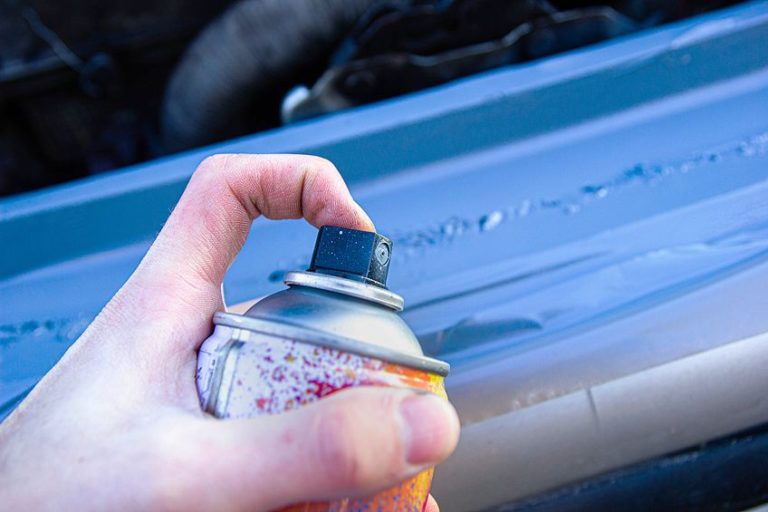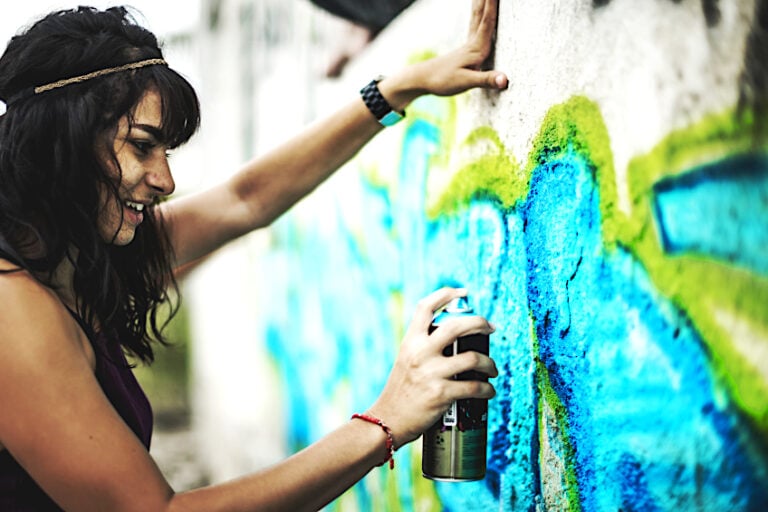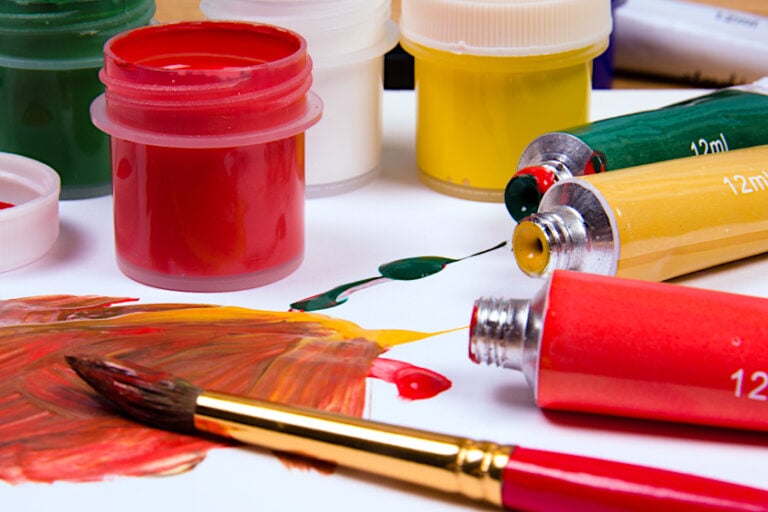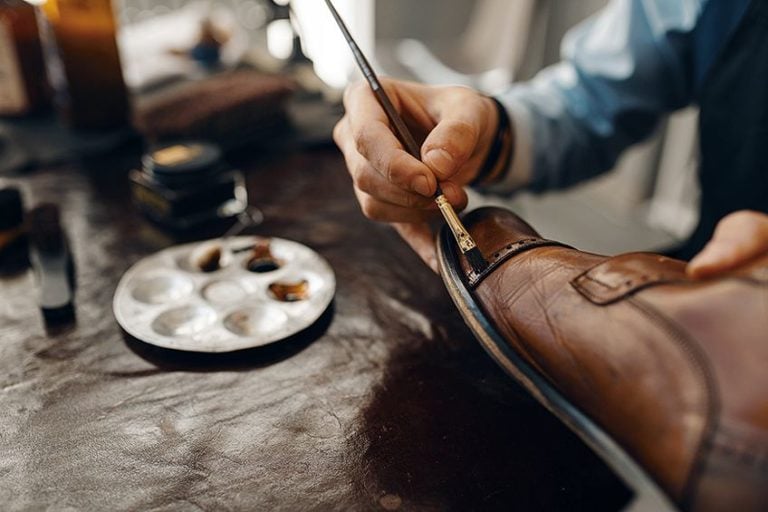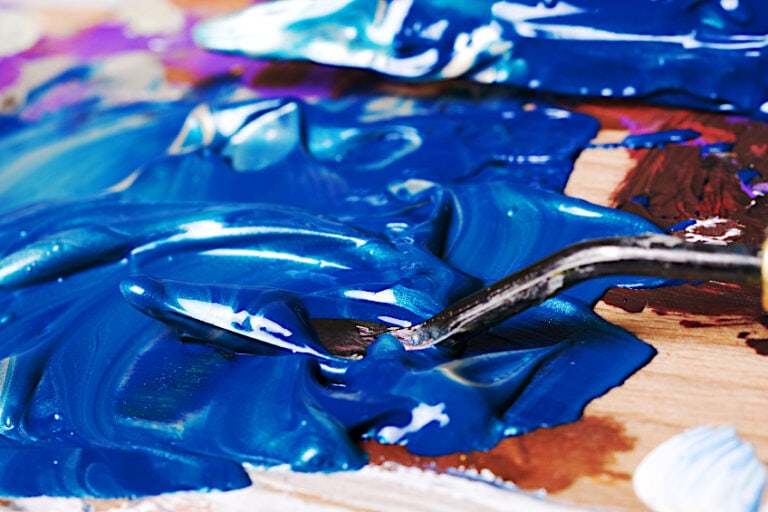How to Clean Acrylic Paint Brushes – Full Guide
This post may contain affiliate links. We may earn a commission from purchases made through them, at no additional cost to you.
If you are reading this article, then you are likely one of those people who have faced the problem of dried acrylic paint on brushes. The brushes become hard as a rock! Dried paint brushes can happen to anyone, even to the best and most cautious artists. We understand that art material is as important as the art itself, so we have come up with this article to help you discover how you can remove acrylic paint from your brushes.
Types of Bristles
Before you decide on a method for removing acrylic paint from your bristles, you must determine the type of bristles you are dealing with. You can either have synthetic bristles or natural bristles. It is hard to remove acrylic paint from synthetic bristles because the bristles are too soft to withstand any chemicals. If soap and water have not worked, then there is no other way of reviving your brushes. Attempting to use harsh chemicals on synthetic bristles will only break them. When dealing with synthetic bristles, you must clean the acrylic paint when it is still wet.
Natural bristles can be squirrel bristles, badger bristles, and so on. You can remove dried acrylic paint from natural bristles because they can withstand harsh chemicals. They cost a little bit more than synthetic bristles because of their durability and clean-ability properties. They are the best money savers as compared to synthetic bristles.
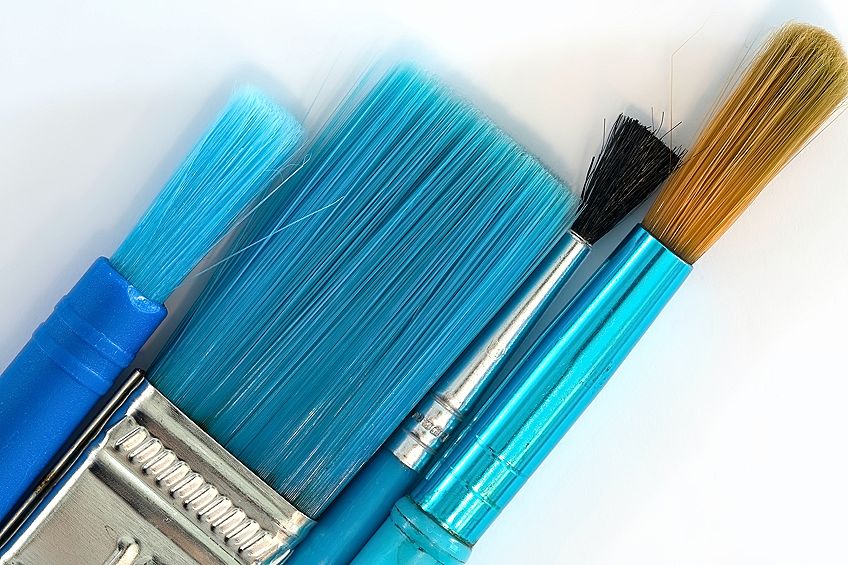
Choosing Your Brushes
Natural brushes are a better choice as compared to synthetic brushes. They are resistant to certain chemicals, especially the chemicals in the acrylic binder, which affects and breaks synthetic bristles. These bristles are easy to clean while the paint is still wet.
Do not clean natural bristles when they are still wet. Natural bristles are not as springy and flexible as synthetic bristles; thus, they are not compatible with acrylic paint. The acrylic emulsion tends to stick to the bristles when wet.
Synthetic brushes are also cheaper, however, if they get stuck with dried acrylic paint then it is a different story. Rubbing alcohol on synthetic bristles as a means of removing dried acrylic paint will destroy the bristles. On the other hand, natural hairs are not affected by rubbing alcohol. The following are some of the ways you can use to remove acrylic paint from your brushes.
How to Wash Paint Brushes Straight After Using Them
Wash your paint brushes in water as soon as you are done working on your masterpiece. Do not leave them to dry with the acrylic paint still on, as this paint is not resoluble once it has dried. So, be cautious and know the kind of paint you will be dealing with.
Make sure that you thoroughly wash your brushes straight after use. The paintbrushes offer you a great and enjoyable moment of fun, so you should also in turn take the time to clean them up for the next session. After you have dipped the brush in water, wipe the paint using a paper towel. Wipe at least two times because most of the paint is removed by the friction of wiping.
Use your fingers to remove any paint that may be stuck at the ferrule of the paintbrush. Make sure you are doing this process while wearing protective gloves. Why is this important? If paint gets into the palm of your hand, the pigment will be embedded into your skin. Take proper care of your hands because you will use them in the next art session.
Once you have mastered the routine of cleaning your brushes after every session, you will enhance their durability and they will remain squeaky clean. If you want a bit more help from an external gadget, you can get a set of paintbrush cleaners.
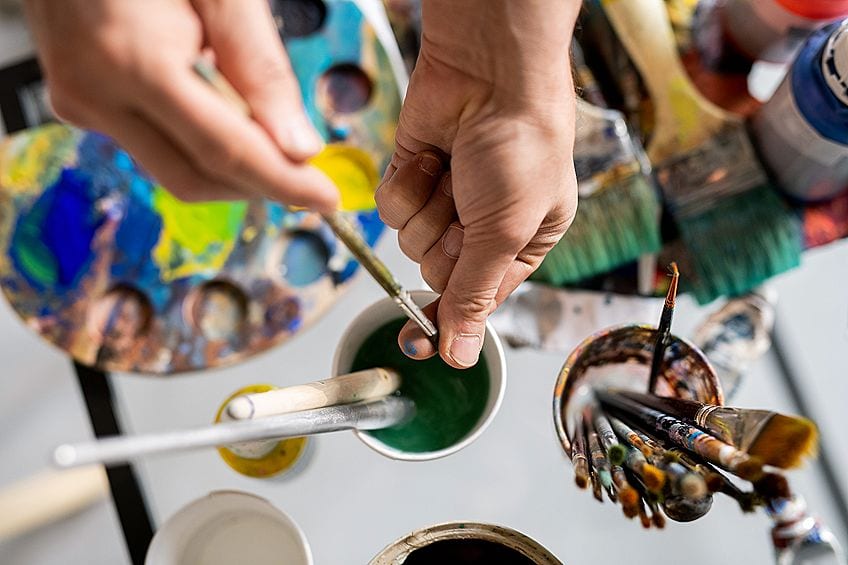
PAINT PUCK Paint Brush Cleaner Set
This set comes with three Paint Puck brush cleaners. They consist of a small paintbrush cup that can fit into different paint cleaning jars, thus making the washing and cleaning process much easier. They also have a suction-cupped bottom that attaches to the bottom of plastic rinse jars. They have soft silicone agitators that can penetrate deeper into the bristles in order to remove paint.
These cleaners can be used at home, in schools, and so on. They are gentle enough to work on the soft bristles of the brush, thus making them durable. The paint puck fits perfectly well into any standard washing and rinsing cup and hyper-saturates the rinsing water.
- This small, versatile fits into Mason jars, cleaning jars, and cups
- Features a suction cup on the bottom to keep them safely in place
- Features soft, silicone agitators that clean paint deep within brushes
PROS
- Suction works perfectly well on different jar bottoms
- Quite easy to clean
- Makes the cleaning process easier and faster
- Great value for money
CONS
- May not stay stuck at the bottom of the jar/bucket at times
Using Soap and Water to Clean Acrylic Paint Brushes
Using a paper towel can remove paint debris from your brush, but does not effectively clean the brush. You can hold your brush under running lukewarm water for at least 5 to 10 seconds, and then rinse it. Continue scrubbing and rotating the brush gently, as the water pressure should remove the debris left from wiping.
Use your fingers to pinch the bristles of the brush while the water is running. You can also opt for a brush comb to completely remove the paint from the brush. Turn off the water, put a teaspoon of soap on the bristles of the brush, then start massaging it with your fingers.
Shampoo is also a good alternative to soap. Work the soap into places where the bristles meet and up to the ferrule. Rinse your brush thoroughly under lukewarm water. Use your fingers to massage the bristles, thus removing all the excess soap under running water.
After the first wash, squirt a small amount of soap in your palm and swirl the bristles on the soap in a circular motion. This process will remove paint in those hard-to-reach areas, especially close to the ferrule. Do a final rinse, and then dry your brush.
How to Remove Dried Paint from Acrylic Brushes
Never be in a haste to throw old brushes away – try to salvage them first. Some brushes have survived acrylic paint before, so yours can be saved too! Use any of the solutions below and get started on the process of reviving your paint brushes.
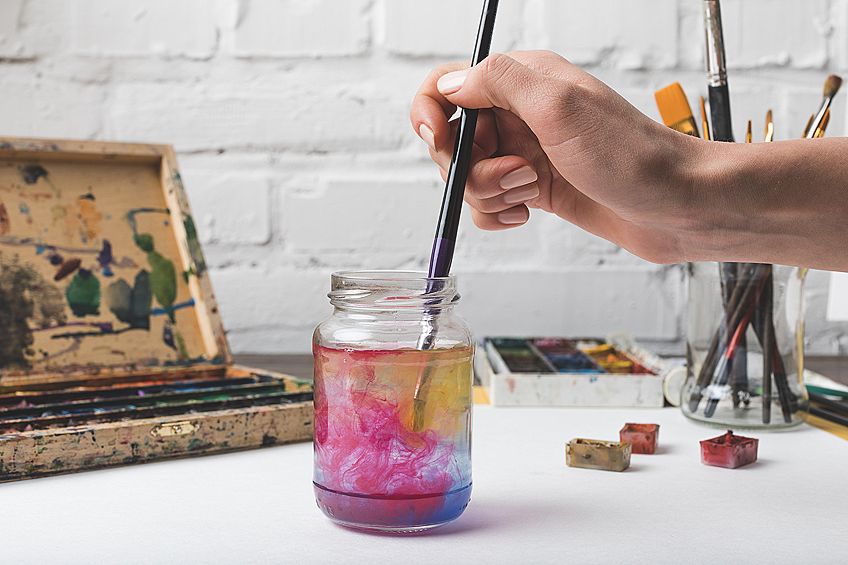
Using Rubbing Alcohol
One such solution requires you to take a jar and fill it with rubbing alcohol. Then, put your brushes into the jar and let them sit for at least five minutes. Do this process in a well-ventilated room, otherwise you can suffocate before the process is complete. Wear protective gloves to protect your hands from alcohol chemicals. You can take out your brushes after five minutes and pull the paint from the bristles.
You can also use a fingernail brush to pull the paint from the bristles. You can do this by rubbing the brushes from the ferrule until you reach the tip. Make sure you are doing this on a paper towel to avoid spilling alcohol everywhere. Rubbing alcohol can work well on natural hair brushes, but not on synthetic hairs. Use Winsor & Newton’s Brush Cleaner if you have synthetic bristles.
WINSOR & NEWTON Brush Cleaner and Restorer
You only need a small amount of this product to get rid of dried acrylic paint from your brushes and save the day. The best amount is 10 ml and below for it to work effectively on your paint brushes. Pour a small amount of the mixture into a glass jar, and leave your brushes to soak in the mixture for up to an hour.
Never leave your brushes soaking in this solution throughout the night, or else you will regret it the following morning. Your wooden handles may be affected by the cleaner. As a final step, boil water and dip the brushes one at a time into the water. Hold the brush in the boiled water for at least 10 to 30 seconds. While the brush is still hot, rearrange the bristles to their normal and natural shape.
- Premium brush cleaner and restorer for dried acrylic and oil paints
- You only need less than 10 ml of this cleaner for effective results
- A non-hazardous, low vapor, and biodegradable product
PROS
- Works well, even on old paintbrushes
- Can work well on other surfaces
- A small amount goes a long way
CONS
- Strong stuff that should be used with care
- Can melt plastic
Using Acetone or Nail Polish Remover
Acetone, commonly sold as nail polish remover, is used by a lot of people for different purposes; thus, it will not be hard to get your hands on a bottle. You can also use acetone to remove dried acrylic paint. You can dip your paint brushes in this acrylic solution, which will then penetrate the bristles of the brush, thus removing all of the acrylic build-ups. The paint particles will break down and dissolve into the solvent.
Note: Acetone is a powerful solution and can cause suffocation. Keep away from children and use it in a well-ventilated area.
Using Hand Sanitizing Gel to Remove Acrylic Paint
You can also remove the debris of acrylic paint from your brushes using hand sanitizing gel. This is because of the ethyl alcohol used in the making of hand sanitizing gel. It is the easiest method that you can use to remove acrylic paint from brushes because it does not require any form of equipment.
The process is quite easy, and you can do it at home. Just squeeze a little bit of the gel on your palm, then rub the brush until the debris of the paint starts falling off. Repeat the process until you get the desired results. Wash your hands and the brush in warm water once you are done with the process.
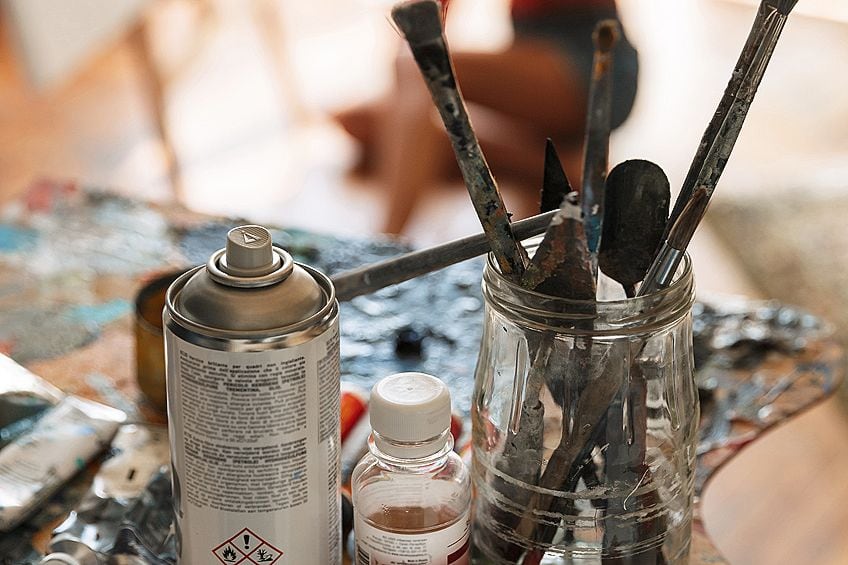
Using an Old Comb to Remove Acrylic Paint
If you have tried everything else and failed, get an old, fine-toothed comb and scrape those stubborn paint particles off your brush. However, you must wet your paintbrush with oil or water first. This will enhance the softness of the bristles, thus enabling the paint to move very smoothly while you are combing.
Make sure that you grip the bristles firmly close to the ferrule, as this will prevent you damaging the bristles. Placing your hand on the base near the ferrule does not only stop the bristles from breaking but also ensures that you do not pull them out during the process.
Trim Your Paintbrush
If you have tried all of the above methods and nothing seems to work at your end, then perhaps you have to accept that your brush is gone. There is nothing more you can do to revive it to a usable state. At this stage, you can only either trim it or throw it away and get a new set of brushes. A trimmed brush can be useful for stippling. You can create other painting techniques using different trimmed brushes.
How to Condition Brushes Regularly
The purpose of conditioning is to enhance the functionality of your brushes so that they continue operating as they did when they were new. Conditioning will ensure that in the process of removing paint from your brushes, you do not lose the softness of the bristles as well.
Get a brush conditioner so that you can save yourself from buying new paintbrushes all the time.
Conditioning will allow brushes to hold their color for a long time. Ordinary hair conditioners can work to help and preserve the softness of your brushes. However, there are also specialized brush conditioners and soaps that you can purchase to restore the bristles of your brushes. The brush cleaner below is one of the best conditioners available on the market.

GENERAL PENCIL B&J The Masters Brush Cleaner and Preserve Tub
This product works well on acrylics, watercolors, glazes, and so on. This is an excellent brush cleaner, and you can use this product as the second stage of the cleaning process. Put The Masters soap in a bucket and keep your brushes inside for a while. It is suitable for both natural hair brushes and synthetic ones as well.
This product is quite easy to use because it rinses quickly. Make sure your brushes are soaked and that the hairs have been completely coated in the soap. Do one brush at a time to ensure that the hairs have been completely covered. Leave the brushes for a while and then rinse them thoroughly with water. Leave your brushes to dry.
- 24 oz tub of brush cleaner to restore and preserve paintbrushes
- This cleaner works on oils, acrylics, watercolors, and more
- Reshape your brushes with a simple one-step total care process
PROS
- Can restore and preserve your stained brushes
- Ability to prevent paint build-ups near the ferrule
- A clear lather of the soap can reshape the brushes
- Revives paintbrushes meant to be thrown away
CONS
- Solution can melt plastics
How to Store Your Brushes to Preserve the Bristles
The durability of your brushes is affected by the way you clean and store them. Make no mistake, paint brushes are as important as the masterpiece itself. Do not leave your brushes upside down in a water jar. Put your brushes on a clean kitchen towel so that they can dry well, and the bristles can get back to shape.
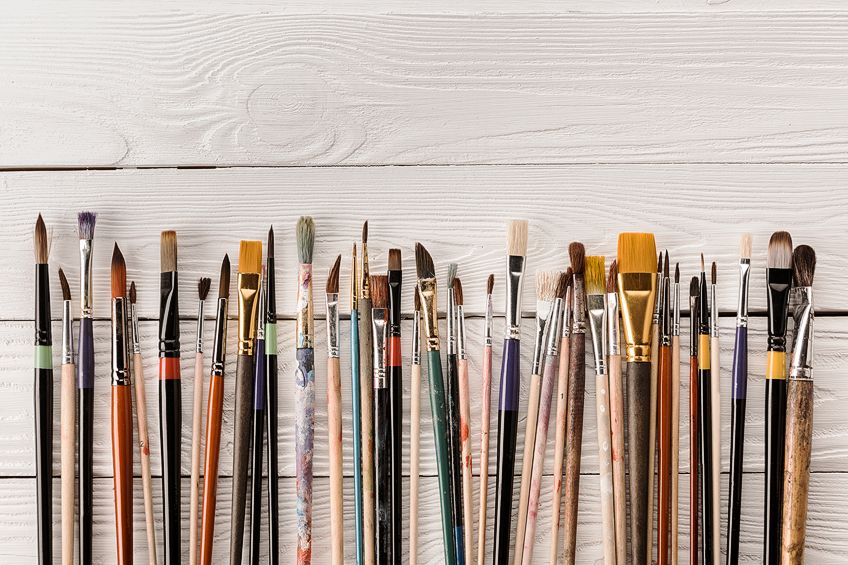
Prevention Methods
This section will deal with some of the ways in which you can try to avoid going through the processes listed above. You must establish a routine that you can follow every time you do your painting so that you do not forget to clean your brushes.
Keep Water Handy
Wet acrylic is water-soluble. Dipping your brushes in water will help in breaking the paint particles. Keep a jar of water handy whenever you are working on your projects. Every time your eyes wander in the direction of the water jar, you will remember to dip your brushes.
Create a Schedule
Setting time aside to clean your brushes is an effective way of ensuring that your brushes will never get stuck with acrylic paint. The idea of creating a schedule may sound lame and unartistic, but it is better to be safe than sorry!
Do Regular Checks
The longer your brushes stay with acrylic paint, the harder it will become to salvage the paintbrush. If weeks have passed by, then the paint might not even come off from the paintbrush. Thus, you must do regular check-ups to ensure that your art equipment is in order.
Never Soak Brushes While Painting
Do not soak some of your brushes in the water while working with the other one. This temptation usually happens if you are using multiple brushes. This is a bad idea because the bristles tend to spread when resting in water, thus bending out of shape. Store your brushes horizontally on a paper towel or sheet while you are working.
Prevent Paint From Getting to the Ferrule
Never be tempted to dip the whole brush completely in paint, as the entire head of the brush should never be submerged into the paint. If you do this, you end up getting paint around the ferrule and it will be difficult to clean it. The result is that the bristles will be damaged. Make sure that only three quarters of the bristles are dipped in the paint for every stroke.
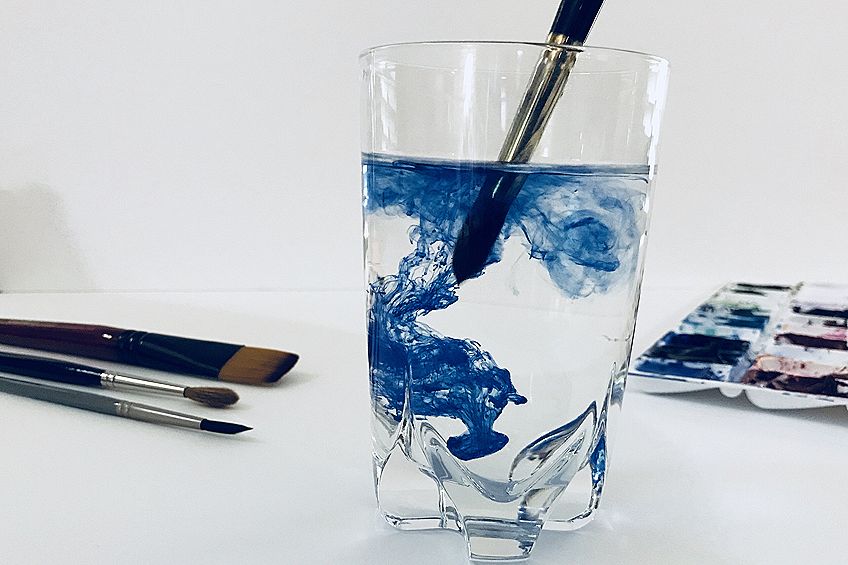
Frequently Asked Questions
Do Acrylic Paint Removal Processes Work?
The process of removing acrylic paint from brushes has a high chance of working. But you must make sure that your brushes do not go on for days without being cleaned.
Can You Leave Your Brush in Chemical Solutions Overnight?
No, you should not leave your brushes in water or chemicals throughout the night. This will break the bristles of the paintbrush.
What Else Can I Do If the Above Processes Do Not Work?
If you have tried several methods and nothing seems to be working, then it is time to accept that your brush is gone and move on. You can either trim the brush and use it for other paintings and creative projects. If you are not interested in trimming, then it is high time you get yourself a new set of paintbrushes.
Larissa Meyer is a 32-year-old mother from Michigan and creative spirit since childhood. Her passion for painting and drawing has led her to an education as an illustrator and a career as a freelance graphic designer. She has a Bachelor of Fine Arts in Illustration and a degree in Graphic Design. Larissa is a talented artist who is able to master a wide range of styles and techniques to bring her artistic vision to life. Her greatest passion is currently fluid painting and epoxy resin art. As a mom of two kids, Larissa also understands the importance of fostering creativity in early childhood. She uses her experience and knowledge to help other parents inspire their children and develop their artistic skills as well.
Learn all about Larissa Meyer and Fluid Painting.







